Ladakh – Spangmik Village on the banks of Pangong Lake
Spangmik is as remote that a village can get but still remains accessible by road. It is almost like being at the edge of the world. A small army check-post bars civilians from going any further towards the border of Tibet. The mountains faraway cause an intrigue generated by lack on information on this sensitive region, making me wonder how the terrain at the other end of the lake would be.
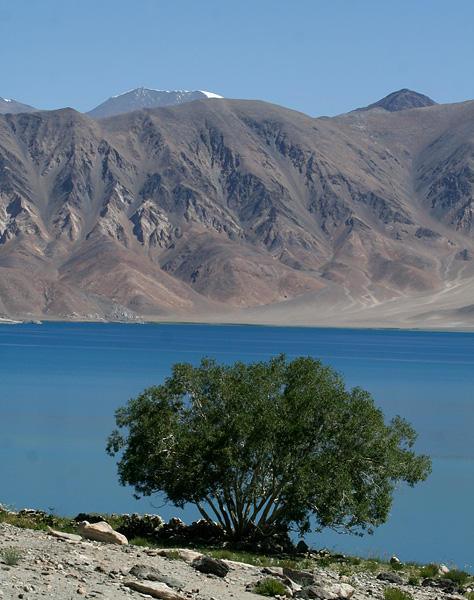
Pangong Lake
The village is located on a narrow stretch of land between the mountains and the lake, with just seven families that make a living by rearing pashmina goats and growing barley during the short summer season. These days, some families rent out a room or two for tourists while a few others work with hotels coming up in the area. Summer is a busy season where a lot of things have to be done together – tending the fields, looking after tourists, taking the goats out for grazing and collecting all necessary resources for a long winter.
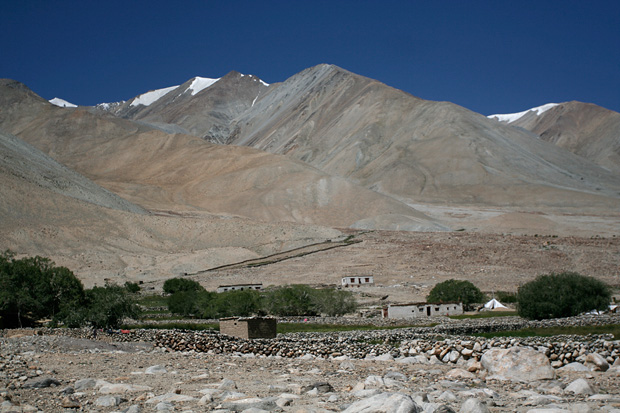
Spangmik Village and the mountain peaks.
Kunchok, the caretaker at our guesthouse gave me some insights to life at Spangmik through the year. He tells me that they grow barley in summer, but not much crop can be extracted from the earth here. Every family owns a few dozen pashmina goats that generate most of their income. “Traders come from all over North India to buy wool of pashmia goats,” he says, “we recently had someone coming from UP.” The wool is sent to Kashmir and Himachal where it is woven into fine cashmere shawls, to be sold all over the world.
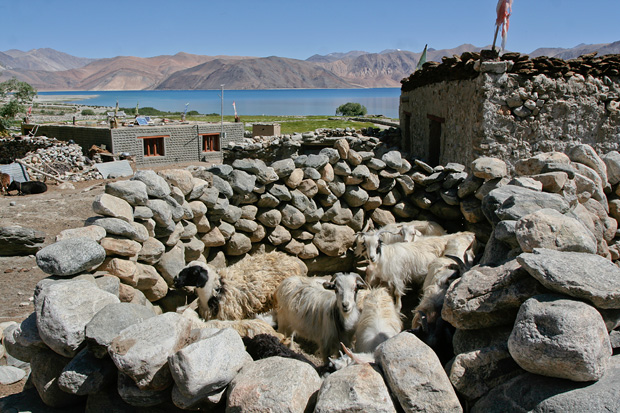
The Pashmimna Goats, Spangmik Village and Paangong Lake.
Most of the activity in Spangmik happens in summer, while winters are months to be spent doing very little work. It is a time when the weather is harsh, the land is snowbound and the lake is frozen. “There isn’t much to do during the cold days,” Kumchok tells me, “we will spend most of our days staying indoors.” But still, they are not the days spent completely idling. The sheep have to be taken care of and the meals have to be cooked, which is a lot of work in itself when you don’t have too many resources at hand. But compared to the busy summers when there is simply too much to do, they have a lot of free time in the cold days.
Unlike many parts of Ladakh that get cut off during the winter months, Spangmik remains connected with Leh by road through the year. “The road through Chang La remains open,” says Kunchok, “we are very close to the border. So, Indian Army ensures that this place is always accessible.” The sensitive border needs to be monitored continuously despite the difficult conditions in winter. “Not many people come here during winter,” Kunchok continues, “but a few tourists do turn up once in a while. The lake will be frozen solid and people even drive their cars on it.”
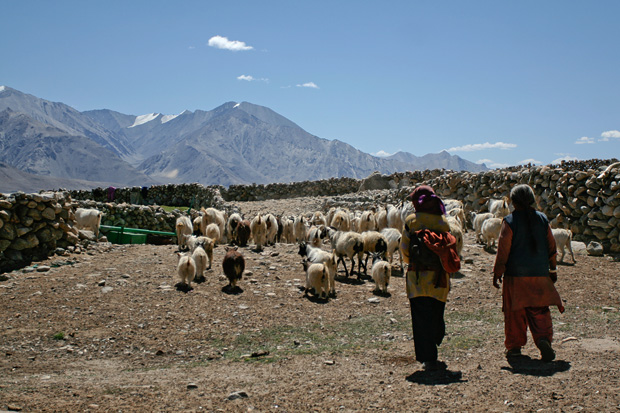
Herding the Pashmina Goats
One of the mornings when I was at Spangmik, I went for a walk in the village to take a look at the goats. They stay confined to small enclosures during the nights and are herded out to the pastures for grazing in the day. They rush out when the gates are opened in the morning, eager to get out and feed through the day. It is a bit of chaos as they run around looking for whatever little grass nearby, but an order is restored very quickly and they march in unison towards the mountains, driven by their herders. I felt an urge to go with them and spend the day in the pastures, but I have only three days in Pangong that I prefer to spend ambling near the lake.
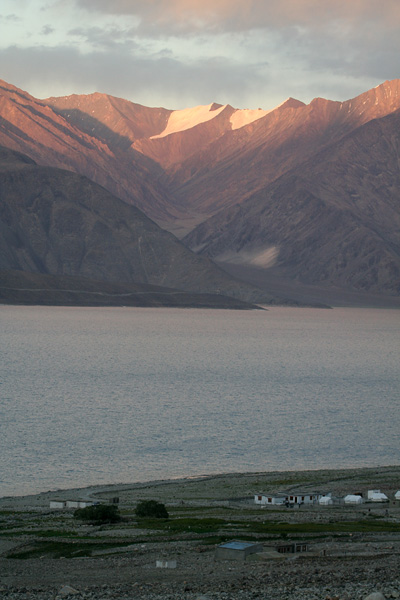
Spangmik Village and Pangong Lake during sunset.
Although I did not make it into the hills with the goat herders, one evening I climbed up one of the lake-facing slopes to the dwelling of a lama who lived alone in a small hut. Unlike many places in Ladakh, Spangmik doesn’t boast of a monastery of its own. The population here is too small to establish and sustain a monastery, but the lama takes care of spiritual needs of the villagers. It is an hour long climb on a gentle slope along a pebble-ridden path crisscrossed by many streams. Once at the top, I was hoping to get a panoramic view of the lake, but the hills closer to the lake limit our views on either side. Yet, it is a different perspective seeing the lake from high up and getting a feel of the scale of the landscape around us.
The remoteness of Spangmik is all the more evident when seen from my high vantage point. The few houses are scattered like dots in a landscape dominated by the long blue stretch of the lake and the barren mountain slopes. It looks like a place out of dreams that is too unreal and too beautiful to be true.
Our three days in Spangmik seemed too short a time to get a good feel of the place. The peace of Spangmik takes a few days to set in and become a part of our system. The peace of the village can slowly let the complicated problems of a larger world go away and have a calm influence over mind and body. But the lure of new things, new places and a desire to be everywhere is hard to resist. A monastic festival at another lake-side village was a temptation that could not be resisted. We left Spangmik, this time not taking the trouble of treading across Pagal Nala, but simply loading the bike on a Gypsy and getting it across the troublesome channel.